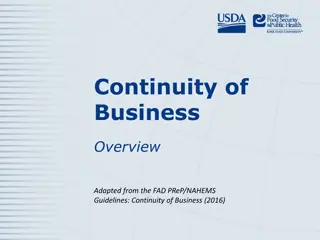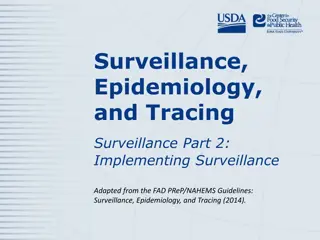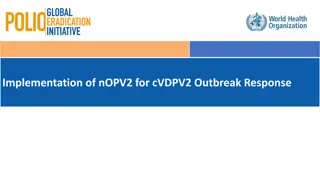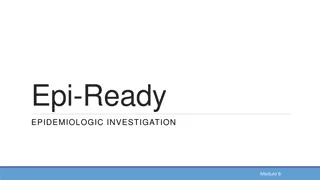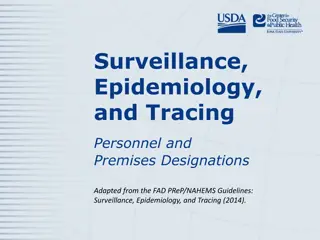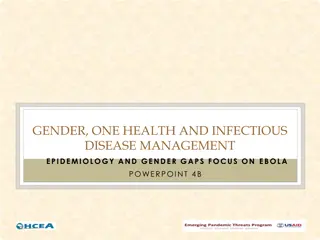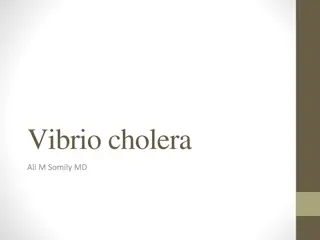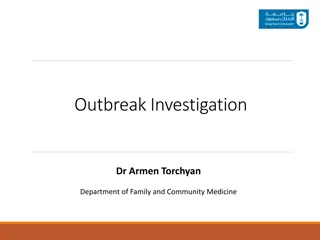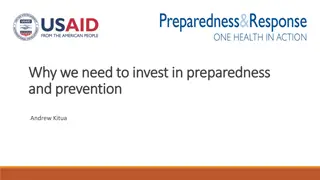Epidemiology Investigation and Response in FAD Outbreaks
This presentation covers the phases of epidemiological investigation in Foreign Animal Disease (FAD) outbreaks, including the descriptive, analytic, and intervention phases. It discusses the collection of information, diagnostic testing, disease risk factors, associations, and identifying the FAD agent and source. The guidelines provided by FAD PReP/NAHEMS, USDA APHIS, and CFSPH are explained in detail.
Download Presentation

Please find below an Image/Link to download the presentation.
The content on the website is provided AS IS for your information and personal use only. It may not be sold, licensed, or shared on other websites without obtaining consent from the author.If you encounter any issues during the download, it is possible that the publisher has removed the file from their server.
You are allowed to download the files provided on this website for personal or commercial use, subject to the condition that they are used lawfully. All files are the property of their respective owners.
The content on the website is provided AS IS for your information and personal use only. It may not be sold, licensed, or shared on other websites without obtaining consent from the author.
E N D
Presentation Transcript
Surveillance, Epidemiology, and Tracing Epidemiology Part 2: Epidemiology in an FAD Outbreak Adapted from the FAD PReP/NAHEMS Guidelines: Surveillance, Epidemiology, and Tracing (2014).
This Presentation Describes the epidemiology investigation and response Descriptive phase Analytic phase Intervention phase Overview of epidemiology principles FAD PReP/NAHEMS Guidelines: Surveillance, Epi, and Tracing - Epidemiology Part 2 USDA APHIS and CFSPH
Epidemiology Investigation and Response FAD PReP/NAHEMS Guidelines: Surveillance, Epi, and Tracing - Epidemiology Part 2 USDA APHIS and CFSPH
Phases of Investigation Generally, disease outbreaks are investigated in three phases: Descriptive phase Analytic phase Intervention phase FAD PReP/NAHEMS Guidelines: Surveillance, Epi, and Tracing - Epidemiology Part 2 USDA APHIS and CFSPH
Descriptive Phase Information collected Case chronology, geography, and demography Case definitions established May later be modified Herd and environmental history considered FAD PReP/NAHEMS Guidelines: Surveillance, Epi, and Tracing - Epidemiology Part 2 USDA APHIS and CFSPH
Descriptive Phase (contd) Diagnostic testing Helps epidemiologists locate new cases Premises with negative test results in the Control Area Retested until quarantine removed Free Premises (in the Free Area) Testing demonstrates Free Area is free of disease. FAD PReP/NAHEMS Guidelines: Surveillance, Epi, and Tracing - Epidemiology Part 2 USDA APHIS and CFSPH
Analytic Phase Descriptive data and corresponding laboratory data are used to determine: Disease risk factors Associations between suspected risk factors and disease status If possible, the FAD agent and source FAD PReP/NAHEMS Guidelines: Surveillance, Epi, and Tracing - Epidemiology Part 2 USDA APHIS and CFSPH
Analytic Phase (contd) Within 96 hours of identifying the index case Characterize the nature of the outbreak Identify risk factors Develop mitigation strategies Within 6 hours of identifying a potential Infected Premises Assign a premises classification Assign a priority of investigation FAD PReP/NAHEMS Guidelines: Surveillance, Epi, and Tracing - Epidemiology Part 2 USDA APHIS and CFSPH
Analytic Phase (contd) Epidemiological investigation reports are generated containing: Information related to the origin of the outbreak Total number of positive animals/premises Total number of states with confirmed positive animals Tracing information FAD PReP/NAHEMS Guidelines: Surveillance, Epi, and Tracing - Epidemiology Part 2 USDA APHIS and CFSPH
Intervention Phase Addresses disease control measures Considers preventive options Assesses economic benefits and consequences of control measures FAD PReP/NAHEMS Guidelines: Surveillance, Epi, and Tracing - Epidemiology Part 2 USDA APHIS and CFSPH
Epidemiological Principles Prevent contact between the FAD agent and susceptible animals Quarantine, movement controls, biosecurity procedures, target depopulation Stop production of FAD agent by infected or exposed animals Slaughter or mass depopulation Increase the disease resistance of susceptible animals to the FAD agent Emergency vaccination FAD PReP/NAHEMS Guidelines: Surveillance, Epi, and Tracing - Epidemiology Part 2 USDA APHIS and CFSPH
For More Information FAD PReP/NAHEMS Guidelines: Surveillance, Epidemiology, and Tracing, and SOP: Surveillance http://www.aphis.usda.gov/fadprep Surveillance, Epidemiology, and Tracing web-based training module http://naherc.sws.iastate.edu/ FAD PReP/NAHEMS Guidelines: Surveillance, Epi, and Tracing - Epidemiology Part 2 USDA APHIS and CFSPH
Guidelines Content Authors (CFSPH) Kerry Leedom Larson, DVM, MPH, PhD, DACVPM Glenda Dvorak, DVM, MPH, DACVPM Janice Mogan, DVM Courtney Blake, BA Reviewers (USDA APHIS VS) Dr. R. Alex Thompson Dr. Lowell Anderson Dr. Steve Goff Dr. Fred Bourgeois FAD PReP/NAHEMS Guidelines: Surveillance, Epi, and Tracing - Epidemiology Part 2 USDA APHIS and CFSPH
Acknowledgments Development of this presentation was by the Center for Food Security and Public Health at Iowa State University through funding from the USDA APHIS Veterinary Services PPT Authors: Patricia Futoma, Veterinary Student; Kerry Leedom Larson, DVM, MPH, PhD, DACVPM Reviewers: Janice Mogan, DVM; Melissa Lang, BS



